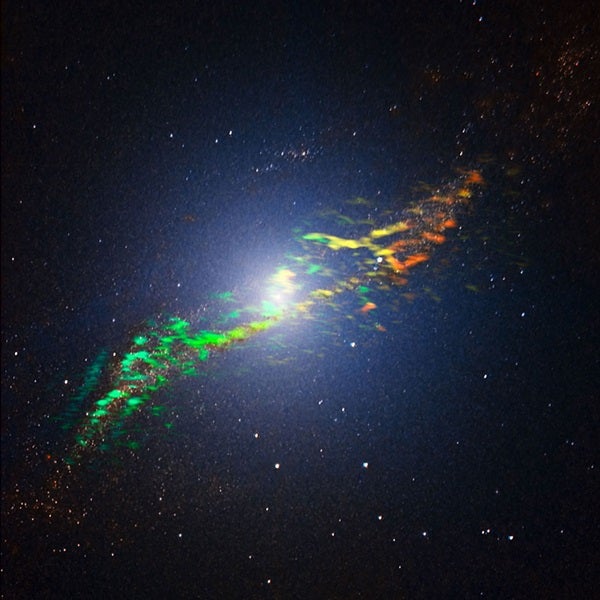Centaurus A is a massive elliptical radio galaxy — a galaxy that emits strong radio waves — and is the most prominent, as well as the nearest, radio galaxy in the sky. Centaurus A has therefore been observed with many different telescopes. Its very luminous center hosts a supermassive black hole with a mass of about 100 million times that of the Sun.
In visible light, a characteristic feature of the galaxy is the dark band that obscures its center. This dust lane harbors large amounts of gas, dust, and young stars. These features, together with the strong radio emission, are evidence that Centaurus A is the result of a collision between a giant elliptical galaxy and a smaller spiral galaxy whose remains form the dusty band.
To see through the obscuring dust in the central band, astronomers need to observe using longer wavelengths of light. This new image of Centaurus A combines observations at wavelengths around one millimeter, made with ALMA, and observations in near-infrared light. It provides a clear view through the dust toward the galaxy’s luminous center.
The new ALMA observations, shown in a range of green, yellow, and orange colors, reveal the position and motion of the clouds of gas in the galaxy. They are the sharpest and most sensitive such observations ever made. ALMA was tuned to detect signals with a wavelength around 1.3 millimeters emitted by molecules of carbon monoxide gas. The motion of the gas in the galaxy causes slight changes to this wavelength due to the Doppler effect. The motion is shown in this image as changes in color. Greener features trace gas coming toward us while more orange features depict gas moving away. We can see that the gas to the left of center is moving toward us, while the gas to the right of center is moving away from us, indicating that the gas is orbiting around the galaxy.
The ALMA observations are overlaid on a near-infrared image of Centaurus A obtained with the SOFI instrument attached to the European Southern Observatory’s (ESO) New Technology Telescope (NTT). The image was processed using an innovative technique that removes the screening effect of the dust. We see a clear ring of stars and clusters glowing in a golden color, the tattered remains of the spiral galaxy being ripped apart by the gravitational pull of the giant elliptical galaxy.
The alignment between the ring of stars seen by the NTT in infrared light and the gas seen by ALMA at millimeter wavelengths highlights different aspects of similar structures in the galaxy. This is an example of how observations with other telescopes can complement these new observations from ALMA.
Construction of ALMA, on the Chajnantor Plateau in northern Chile, will be completed in 2013 when 66 high-precision antennas will be fully operational. Half of the antennas have already been installed. Early scientific observations with a partial array began in 2011 and are already producing outstanding results.










